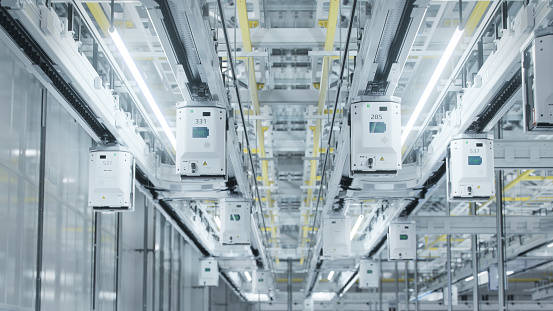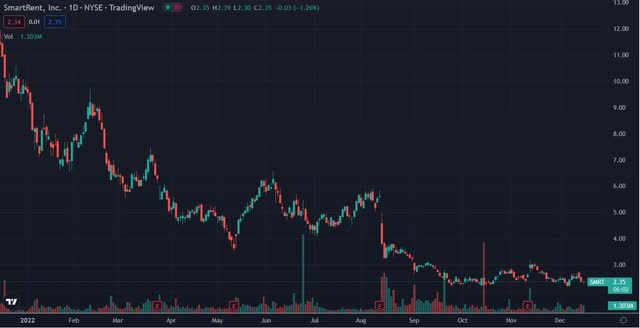SweetBunFactory/iStock via Getty Images
SmartRent, Inc. (NYSE:SMRT), like most stocks, has taken a big hit on its share price, even though demand for its products and services continues to climb.
By far, the major headwind the company faces is its supply chain, which at this time simply can’t meet the growing demand, resulting in the company underperforming for a while now.
The way management describes it is they are putting out thousands of orders and only getting hundreds that are delivered. The big question going forward is how long it’s going to take for the supply chain issues to be resolved to the point it has a material impact on the performance of SMRT.
In this article we’ll look at some of its latest numbers, the challenge of its supply chain, and what it means for the company if it takes longer than expected to turn around.
Some of the numbers
The good news in regard to revenue in the third quarter was it came in at a record $47.5 million, up 12 percent from the $42.4 million in revenue generated in the second quarter, and 35 percent year-over-year. The bad news was Professional Services revenue plummeted 18 percent because supply chain constraints resulted in lower deliveries. On the other hand, Hardware revenue was up 28 percent while Hosted Services revenue increased 8 percent. Gross margin in the reporting period was 2.5 percent, slightly up from the 2.3 percent sequentially. With Hardware being a significant portion of its revenue, the 4.7 percent in gross margin offset the margin of 51.2 percent in Hosted Services.
Adjusted EBITDA was negative $(17.6) million, up 11 percent from the prior quarter, but down 9 percent year-over-year.
Net loss in the third quarter was $(26.0) million, down 1 percent from the previous quarter.
At the end of the quarter the company had $217.4 million in cash and held no debt. It also has a $75 million revolving line of credit.
As for guidance, it upwardly revised its revenue outlook for 2022 from $155 million to $180 million, to $165 million to $180 million. Adjusted EBITDA for full-year 2022 is projected to be from negative $(75) million to negative $(70) million.
Concerning units deployed for full-year 2022, the new guidance is for it to come in at 200,000 to 220,000 units, up from prior guidance of 190,000 to 220,000 units.
The improved guidance in revenue and deployed units suggests to me it may have enough supply coming in to have an impact on the low end of guidance, but not the high end, meaning the supply chain constraints are still a significant factor in its performance.
The goal of the company is to achieve positive adjusted EBITDA sometime in 2023. While it’s not a bad goal, it’s much easier said than done under current supply chain constraints, which will limit scale.
If its SaaS business is able to continue to grow, that will be a positive step toward achieving positive adjusted EBITDA because it has higher margin. Revenue in that category was up almost 4x from last year, so if it can continue to grow at a fairly fast pace, it could help the company surprise to the upside, especially if its supply chain continues to remain under pressure.
Demand, supply chain and backlog
Concerning demand, it remains robust as evidenced by the more than 800,000 in “committed units expected to come under the platform in the next 2 years.” And within its existing customer base they own or operate over 6.5 million units in total, pointing to a lot more potential wins if supply constraints are relieved.
Management pointed to what it considered some “easing” in the supply chain; it didn’t sound like it would be enough to make a big difference in the performance of the company in the near term.
On a positive note, the business model of SMRT is to primarily retrofit existing apartments, so construction delays and slowdowns from other related factors aren’t a headwind for the company. If overall improvement in its supply chain continues, it could result in positive free cash flow in the second half of 2023. At this stage I don’t think there is enough clarity to justify drawing that conclusion.
So, while demand continues to be strong, the company isn’t going to get the tailwind it needs to break out of its recent trading range unless it receives the parts it needs to do business.
Cash burn in the latest quarter was approximately $46 million, primarily from accounts receivable being about $20 million higher than the prior quarter. That’s something for investors to watch to make sure it was an anomaly and not a negative trend forming. If collections become an issue, then it changes the demand narrative if companies aren’t will to or can’t pay.
SMRT has a strong balance sheet and enough cash flow to endure a period of cash burn, but it would definitely change the way the market views the company.
Share price and trading considerations
The share price of SMRT over the last year has traded from a 52-week high of $11.94, to a 52-week low of $2.14 on December 6, 2022. Since it dropped to the low $2s on September 26, 2022, the stock has traded sideways in a tight range from $2.20 per share to $2.70 per share, with a brief move above it.
What that tells me is the market is looking for a catalyst that will change the performance of the company going forward.
As mentioned throughout this article, the major issue the company faces is associated with its supply chain. I don’t think the share price is going to break out on the upside until the supply chain is shown to be sustainably improved to a level that results in it being able to meet growing demand. Until that happens, I think the company will be considered one with the inability to reach its potential, even though the supply chain isn’t something the company has control over.
While the backlog is a positive for the company, at the same time it points to the fact it’s falling being its installment schedule, which is why it has lowered some of its guidance.
Conclusion
There’s a lot of positive things that could be said about SMRT, including its business model and strong demand, but at this time the challenge the company faces isn’t one of demand or the market is competes in, but the inability for it to get the parts it needs to accelerate its growth at the potential it inherently has with growing demand.
It has more than enough capital and solid balance sheet to endure for a significant period of time while the supply chain improves, but it’s leaving a lot on the table right now, and if it goes on for a long period of time, it’s not certain how that will impact the backlog over the next year or two.
That’s especially true if the recession gets worse for longer and its customers decide to hold off on spending in order to take a defensive position in order to preserve capital.
A problem for SMRT is it can announce more wins, such as it did on December 1, 2022, when it announced a partnership with SFR Capital Management integrate its tech into its investment portfolio, which is projected to grow by more than 35,000 homes over the next 5-7 years. The market basically yawned on the news as the share price fell further not long afterwards to its 52-week low.
The reason for that is the market already is aware of the demand for the tech of SMRT, but it’s also aware that won’t change the performance of the company until it has available parts to install its products.
Even with the slight improvement in its supply chain in the recent past, I really don’t think there’s any way of knowing whether or not it’s sustainable. Until the market does know that I think the stock is going to continue to trade sideways in a fairly tight range.



Be the first to comment